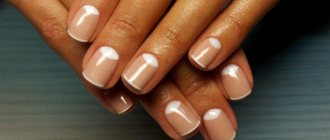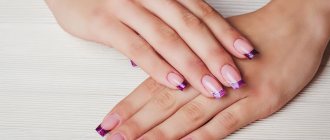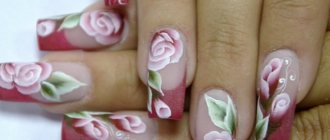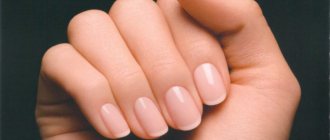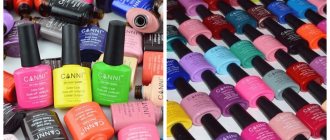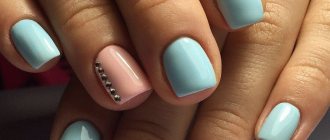What is the difference between gel and regular polish?
Nail gels vary in purpose. Among them are means for lengthening the nail plate, as well as strengthening biogels that help prevent delamination. The purpose of gel polish is similar to ordinary nail polish - it is used to decorate nails.
The main differences between gel and simple varnish can be seen in the table:
| Distinctive features | Gel polish | Regular varnish |
| Application | Preliminary preparation of the nail plate is required (filing, degreasing, applying a base). | Before you start, just degrease your nails. |
| Drying | Dries only under a special lamp for 2-3 minutes. | Air dries in 5-10 minutes. |
| Wearing period | The manicure remains beautiful for about 3 weeks. | Nails look untidy after 2-4 days. |
| Removal | Dissolves with a special liquid in 15 minutes. | Easily wiped off with a cotton pad soaked in nail polish remover. |
Another distinguishing feature between gel and regular varnish is cost. Gel polish is more expensive. And since the application procedure requires certain skills, they also pay separately for the services of the master.
Apply gel polish
Now you need to apply the color coat. This must be done according to the same algorithm that you used to apply the base coat. Cover all nails with gel polish, then dry them in a UV lamp.
It is important to remember some tricks:
- You should not try to apply shellac in a thick layer. Many girls, trying to achieve a bright, rich color as quickly as possible, put too much product on their brush. This should not be done: bubbles may appear on the coating, and the lower layers of shellac will not be able to polymerize, as a result of which shellac will last as long as regular varnish;
- take your time: shellac does not dry out in the air, so you can easily remove all imperfections using a cotton swab;
- at this stage you can use various decorative elements, such as rhinestones or sliders. You can fix the decor on top of the sticky layer. By the way, you will learn about ways to make a manicure with gel polish more interesting in the following sections.
For more precise application, use a thin synthetic brush rather than a brush from a bottle of varnish.
Advice! To make application more precise, use a thin synthetic brush rather than a brush from a bottle of varnish. This will allow you to get a neat manicure that will look like it was done by an experienced nail technician.
Composition of gel polish
Gel polish contains molecules that react and turn into a polymer, that is, they harden. They are called monomers and oligomers. The composition contains special photoinitiators. These are particles that actively absorb UV radiation and help the gel polish become hard.
Also, the gel contains the following substances:
- solvents;
- coloring pigments;
- fragrances;
- formaldehyde;
- methylisothiazolinone;
- dibutyl phthalate;
- toluene.
The last 4 substances on the list are considered toxic in large quantities and can cause allergies. In gel polish their concentration is so low that it does not pose a health hazard.
Removing gel polish
We have figured out how to properly apply Shellac coating, now let's look at how to remove its remnants.
For this procedure we will need:
- Special liquid for dissolving gel polish.
- Cotton balls (10 pcs.).
- Aluminum foil.
- Orange sticks.
Removing gel polish should be approached with special care, as you can damage the nail plate.
We soak the prepared cotton balls with gel polish remover.- Apply them to each nail one by one and wrap tightly with foil. You should work in accelerated mode, since the special solution tends to evaporate quickly.
- We wait 10 – 15 minutes.
- One by one, we begin to remove the foil and, using an orange stick, carefully pry off the softened gel polish.
- Remains of Shellac can be removed with a regular buff.
At this stage, simple gel polish nail design for beginners is over. Now your nails are completely ready for treatment and a new coating of gel polish.
Which gel polish is better to choose?
For beginners creating nail designs, it is important to choose the right gel polish. It is necessary to pay attention to the hypoallergenicity of the product and its durability. These parameters are indicated on the packaging. There are several popular manufacturers that have earned the trust of experienced nail artists.
Scroll:
- Shellac CND.
- Entity.
- Ibd.
- Kodi Professional.
These gel polishes apply well, have high durability, and are also easy to remove. The color palette of each brand allows you to create any design. For a quality manicure, it is important to choose the right gel and choose good base and top coats. It is recommended to buy products from the same brand as the gel polish.
Why choose gel polish?
Let's figure out why manicure with gel polish is widespread among young people and is very popular among older women? The experience of designing using gel polish reveals its positive aspects:
- The nail plate is significantly strengthened.
- Nails are protected from exposure to chemicals.
- Before application, the nail is not filed down (as with extensions), but only the glossy layer is removed.
- This manicure lasts up to three weeks.
- The varnish is absolutely odorless, which makes it non-toxic.
- Gives excellent results with a dazzling gloss.
- With a high-quality manicure, it can be worn without chipping.
Covering your nails with gel polish at home is quite simple; it is important to have the necessary materials and clearly know the process of applying shellac to your nails.
How to choose a UV lamp for drying gel polish at home
Lamps for drying gel polish vary in power, as well as in the type of light emitters installed inside. Ultraviolet lamps dry not only gel polish, but also other extension products. Models with a power of 36 W are suitable for home use. Such devices have 2 disadvantages. Bulbs quickly burn out and require replacement with identical ones.
Other lamps will not work. UV radiation negatively affects the skin of the hands. After drying, it is necessary to use moisturizing oils and special creams. There are LED lamps that do not negatively affect the skin and dry the gel coating faster than ultraviolet lamps. The light bulbs in such devices last a very long time, and energy consumption is reduced by half.
For home use, devices with a power of 6 W are suitable. The disadvantage of such dryers is their high price.
There are hybrid lamps that contain both types of bulbs. They reduce the drying time of the coating from 2-3 minutes to 30 seconds. Their power is enough to dry any design, as well as gel for extensions.
For home use, it is recommended to purchase small-sized devices with low power. Their cost is low and drying is carried out properly. Large and powerful lamps are needed for salons where there is a large flow of clients. In a large device you can dry both hands at the same time, thus saving time.
What to draw with?
Nail design for beginners will not be particularly difficult. The main thing is to choose the right tools and learn how to use them. To create beautiful designs on nails, masters use special devices, which are discussed later in the article.
Tassels
To create unique designs, you will need to purchase a set of manicure brushes. Each of them is designed to create specific patterns. Thin ones can be used as a French pattern and stripes can be applied. Fluffy brushes are used to create various effects, such as ombre or graffiti.
Dots
This is a tool with a metal tip that has a small ball. It is used to apply smooth, round dots or peas. The shape of the tip allows you to pick up a small amount of polish and carefully distribute it over the nail.
Needles
Thin needles are used to create neat lines. Typically, designs are made from 1 or several small drops of varnish, smearing them in the desired direction. The result is a very unusual effect.
Pieces of tulle
Tulle can be used as a stamp. A small piece is soaked in gel and carefully applied to the nail.
Press the tulle against the plate for 2-3 seconds and carefully remove it. The result is a beautiful “lace” design.
Foil
Unusual patterns are created from foil by gluing small pieces onto the plate immediately after drying. The design is then secured by applying a base coat. You can use regular foil or a special shiny film for nails. There are foil threads and narrow ribbons, which are similarly used in manicure.
Sponge
Using a small piece of foam sponge, you can achieve a smooth transition from one color of varnish to another. Such effects are called gradient or ombre.
Sliders
These are stickers, the design from which can be transferred to the nail plate by moistening the picture with water. Sliders can cover the entire nail or a small part. You can cut out different pictures and combine them with each other. After applying the design, it must be secured with a base.
Powders
Special powders are used both to cover the entire nail and to create beautiful three-dimensional patterns. Powders can be shiny, have rubbing properties, or give the coating a velvety surface.
Training cards, stencils
Training cards are printed stencils on which you can practice carefully applying patterns. The training system is reminiscent of school rules. The card shows a pattern that needs to be repeated. First, they trace the picture along the outlined lines, and then try to draw it themselves. Nail designs for beginners with designs can be difficult to execute.
If you can’t draw patterns by hand yet, you can use special stencils. This method of applying a design is called stamping. A pattern is engraved on the metal plate.
The varnish is applied to the plate and distributed evenly with a plastic spatula. A special rubber sponge is pressed against the plate and then against the nail. The design is transferred to the nails like a stamp. All that remains is to dry it and seal it with the final coating.
Step-by-step gel manicure for beginners
Regardless of the design, gel manicure must be performed strictly following the sequence of actions. Before applying the gel, it is important to prepare each nail by applying a base coat. Then distribute the colored varnish correctly and secure it well with topcoat. Below is a step-by-step description of each of these stages.
Applying base coat
Before applying the base, you need to treat the nail:
- The plate is given the correct shape and the cuticle is carefully pushed back or cut off.
- A thin layer is removed from the nail using a coarse-grained buff. It is necessary to give the plate a matte surface. Do not press the buff too hard, otherwise you may injure the nail.
- The dust is swept away with a brush and the plate is degreased with a special product.
- If your nails are thin and bend easily, then you need to apply a primer.
- The base coat is applied in a thin layer from the edge of the nail to its root, and then from the cuticle towards the edge.
- The coating must be dried in a lamp.
Nail designs with gel polish for beginners begin with applying a base, as in the photo.
In UV lamps the drying time takes 1 minute, and in LED lamps it takes 10-15 seconds.
Applying gel polish
Colored varnish is applied in 1 layer to obtain a translucent color.
For a rich color you need to apply 2-3 layers:
- Application begins from the middle of the nail at the bottom, smoothly moving upward.
- When painting the sides of the plate, it is important to ensure that the gel covers the surface completely, without gaps.
- Each layer of gel polish must be dried in turn for a minute. In an LED device – 30 sec.
Particular attention should be paid to the last point. If you do not dry the layers and apply more varnish, the coating will swell or crack.
Applying top
The final coating is necessary to securely consolidate the result:
- The top is applied in the same way as colored varnish. The layer should be a little thicker.
- The ends of the nails must be completely sealed.
- The coating is dried for 2-3 minutes. In LED lamp 30 sec.
The top coat gives nails strength and shine. To achieve a matte effect, you can purchase a special finish or use colorless powder.
Gel polish designs on nails
If a single-color palette for nail design seems boring, you can experiment like an artist, that is, make drawings on a single-color background. There are many options, but the specifics of application are not very different:
- Applying patterns with gel polish of other shades using special tools after the first layer has dried.
- Mixing two or more shades of wet gel polish.
Gel polish drawings
- The main tone is applied, usually bright or dark colors - red, black, blue, green and others. Dries in a lamp.
- The sticky layer is removed with a degreasing compound (cliner).
- Using a special brush or dots, a pattern is applied with a different color of gel polish and dried again.
- At the end of the process, the nail is coated with a finishing compound.
Try to make a bright Gzhel manicure by painting patterns with gel polish:
Mixing shades of gel polish on nails
- Painting with gel polish is carried out with a second layer, that is, after the base color has dried. It is not necessary to remove the stickiness.
- Using a thin brush, apply several colors of the hybrid in the form of stripes.
- We draw waves and cross lines at the junction of colors with a needle, brush or dots.
It turns out to be a variant of drawing on a wet layer. The technology of this design can be seen in videos shared by masters on the Internet.
If the gloss on your nails is tiring and you want to make your manicure matte, it is enough at the end of the procedure, when the finishing layer has been applied and dried, to lightly work with a soft sander from the edge of the nail to the cuticle. The shine will come off, but the gel polish designs on your nails will look amazing.
Mixed technique is very suitable for performing a gradient manicure, and how to do such a manicure - see the video tutorial:
Simple and beautiful nail design with gel polish for beginners
Nail design for beginners should be easy to do. You can learn to create simple drawings, which are the basis for creating more complex patterns. Below are descriptions of the most popular nail design options.
Dot patterns
The dots can cover the entire surface of the nail or form a specific pattern.
Patterns are applied using dots onto a dried base or onto a colored layer:
- Select a suitable shade of varnish for the dots to match the main color of the nail.
- The instrument is placed into the open bottle after pre-treating it with a degreaser.
- To get a big point. You need to submerge the entire tip in the gel. To create a fine dot, just touch the varnish with a ball on the end.
- The dots are pressed against the nail for 1-2 seconds, the varnish flows off, forming a perfectly round spot.
- The pattern is dried in a lamp for 1-2 minutes.
To set even points. You need to practice on plastic tips or training cards.
Hearts using a toothpick
You can draw mini hearts on your nails without using brushes:
- Using a dot, place 2 drops of gel on the dried base, placing them at the same level, close to each other.
- Use a toothpick to carefully connect the drops in the middle, leaving two round tops.
- Towards the bottom of the drop you need to stretch it a little to get the end of the heart.
The drawing needs to be dried in a lamp and secured with a topcoat.
Drawings using stencils
Using stamping is considered one of the simplest design options:
- Select a pattern from a plate with drawings and fill it with gel polish.
- Using a plastic spatula, remove excess from the plate.
- The silicone stamp is pressed tightly against the design, and then the design is transferred to the nail.
- Dry the layer in a lamp.
It is important to work with the stamp carefully, preventing it from slipping either from the plate or from the nail. Otherwise the drawing will be smudged.
Abstraction
The most popular type of abstraction on nails is brush strokes:
- On the dried base you need to apply small strokes in different directions using a flat brush.
- If you are planning a pattern of several colors. Then the strokes of each color are dried separately.
Abstraction can be done using foil, stamping and self-adhesive strips.
Stickers
To transfer a design to a nail, you need:
- Apply base and main color.
- Peel off the film protecting the sticky layer from the sticker.
- Place the slider in the desired part of the nail and press gently.
- Place some water on the sticker and press it down gently.
- Remove the slider after 1 minute.
- Secure the design with a finishing coat and dry it.
There are non-transferable sliders. They are simply placed on the plate and secured with topcoat.
Nail art geometry using tape
Geometric patterns are easy to create using tape:
- The adhesive tape is cut into strips or other shapes.
- Glue pieces of tape onto the dried 1st layer and cover the nail with varnish.
- Remove the tape with tweezers and dry the coating in a lamp.
If the varnish applied over the tape is liquid, then it is recommended to dry the nail for 15 seconds and remove the tape.
Broken glass
This effect is achieved using foil:
- The material is cut into small pieces.
- “Glass” is laid out on the dried base.
- Cover the plate with a finishing coating.
They sell pre-cut pieces to create this effect.
Painting Watermelon with a brush
This summer manicure is very easy to do:
- Red is chosen as the main color. The layer is dried.
- The French is painted in green and dried again.
- The border between red and green is emphasized with a thin white line.
- Black gel is used to add dots that imitate seeds.
- Dry the layer and secure the design with a top coat.
You can use only green color in 2 shades and draw stripes, like on the rind of a watermelon.
Gradient
The gradient can be made using a foam sponge:
- A light gel polish is applied and dried as a base.
- Apply 2 colors of gel to the sponge.
- Using wetting movements, the colors are transferred to the nails.
- The colored layer is dried and then the base is applied.
It is important to choose matching colors.
Lunar manicure
This effect is very simple. On the main color, using a brush, draw an even hole near the cuticle. You can use different colors, the main thing is that they match.
Monograms
This is what we call ornate patterns. They are applied using thin brushes. Before creating such a design, you need to practice using stencils.
French
French is called French manicure. It will be difficult for beginners to draw it smoothly, so it is worth purchasing special templates. French can be not only white, but also colored, shiny or black.
Flowers
To draw a simple flower, you will need dots and gel polish in 2 colors:
- Dots apply a central drop onto a dry base. This will be the middle of the flower.
- After cleaning the instrument, dip it in a different color and place several drops around the first at the same distance.
The flower petals can be left round or stretched to the sides with a needle.
Decoration
You can decorate a gel manicure in different ways. It all depends on the skills and imagination of the master. The easiest ways to give your nails a beautiful look are described below.
Rhinestones
The rhinestones are placed using tweezers onto the damp base coat. You need to gently press the jewelry onto the nail for 1-2 seconds.
And then dry it in a lamp. It is important to use only special rhinestones for nails so that they do not become deformed when drying.
Acrylic powder or sand
Using powder and sand, you can give the surface a rough appearance or, conversely, add shine. Depending on the desired effect, the base is applied on top of the jewelry or under it.
Sequins
Sequins come in small and large sizes. The smallest glitter looks like powder. It's called rubbing. They are applied with a brush onto a dried base. The result is an interesting mirror surface, which is additionally secured with a top coat. Large glitters are placed on the nail using tweezers.
Openwork
You can achieve an “openwork” effect in 3 ways. You can use tulle, stamping or sliders. Everything except the sliders must first be dried and then covered with the final layer.
Removing gel polish
Gel polish takes longer to remove than regular polish.
This procedure requires a special liquid, foil with sponges and 15 minutes:
- Sponges are soaked in nail polish remover and applied to the nails.
- Fingers are wrapped in foil to prevent the liquid from evaporating.
- After 15 minutes, remove the foil from 1 finger and remove the varnish with a wooden spatula.
It is important to remove the foil only before removing the varnish. If you remove it from all fingers at once, then while cleaning one, the rest of the varnish may harden.
Nail design is easy to learn. Beginners need to practice more and constantly improve their skills. Gradually, creating a beautiful manicure can grow from a hobby into a profitable business. The main thing is to follow all the rules for applying gel polish and choose high-quality material for the job.
Article design: Oleg Lozinsky
Training on how to create a manicure and apply gel polish through video tutorials
Visual perception plays a very important role in our daily lives, helping in learning and making it possible to convey important information quickly and clearly. First we look, then we process what we see and in a matter of minutes we understand what needs to be done.
In the modern world, most women perceive visual information much better than huge canvases with many letters. Therefore, I suggest you watch a few video tutorials on how to create a manicure with gel polish . I tried to make for you a selection of the most useful video materials, which at one time helped me a lot in becoming a professional in the field of creating gel polish manicure.
Videos for beginners
Video tutorial No. 1 “Full review: starter kit for gel polish. Part 1"
Video tutorial No. 2 “Full review: starter kit for gel polish. Part 2"
Video lesson No. 3 “Removing the old coating and making a new one”
Video tutorial No. 4 “Gel polish manicure at home with a detailed discussion of all sorts of subtleties”
Video tutorial No. 5 “How to apply/remove gel polish”
Video master class from professional cosmetologists
Video No. 1 “Step-by-step instructions for applying gel polish”
Video No. 2 “Three effective ways to remove gel polish”
Video No. 3 “Removing gel polish with a cutter + hardware manicure. Part 1"
Video No. 4 “Complicated repair, extension and straightening of nails. Part 2"
Video No. 5 “Gel polish correction. Combined manicure for beginners with one cutter. Part 1"
Video No. 6 “Applying gel polish under the cuticle: leveling + strengthening + highlights. Part 2"
